Corporate Finance: Strategies, CAPM, Share Price Calculation, P/E Ratio, RRR Method
VerifiedAdded on 2023/06/12
|9
|1427
|498
AI Summary
This study material on corporate finance covers Wesfarmers strategies, core values, CAPM, share price calculation using dividend and non-dividend discount models, P/E ratio, and RRR method. It also includes information on the company's financial ratios and competitors.
Contribute Materials
Your contribution can guide someone’s learning journey. Share your
documents today.
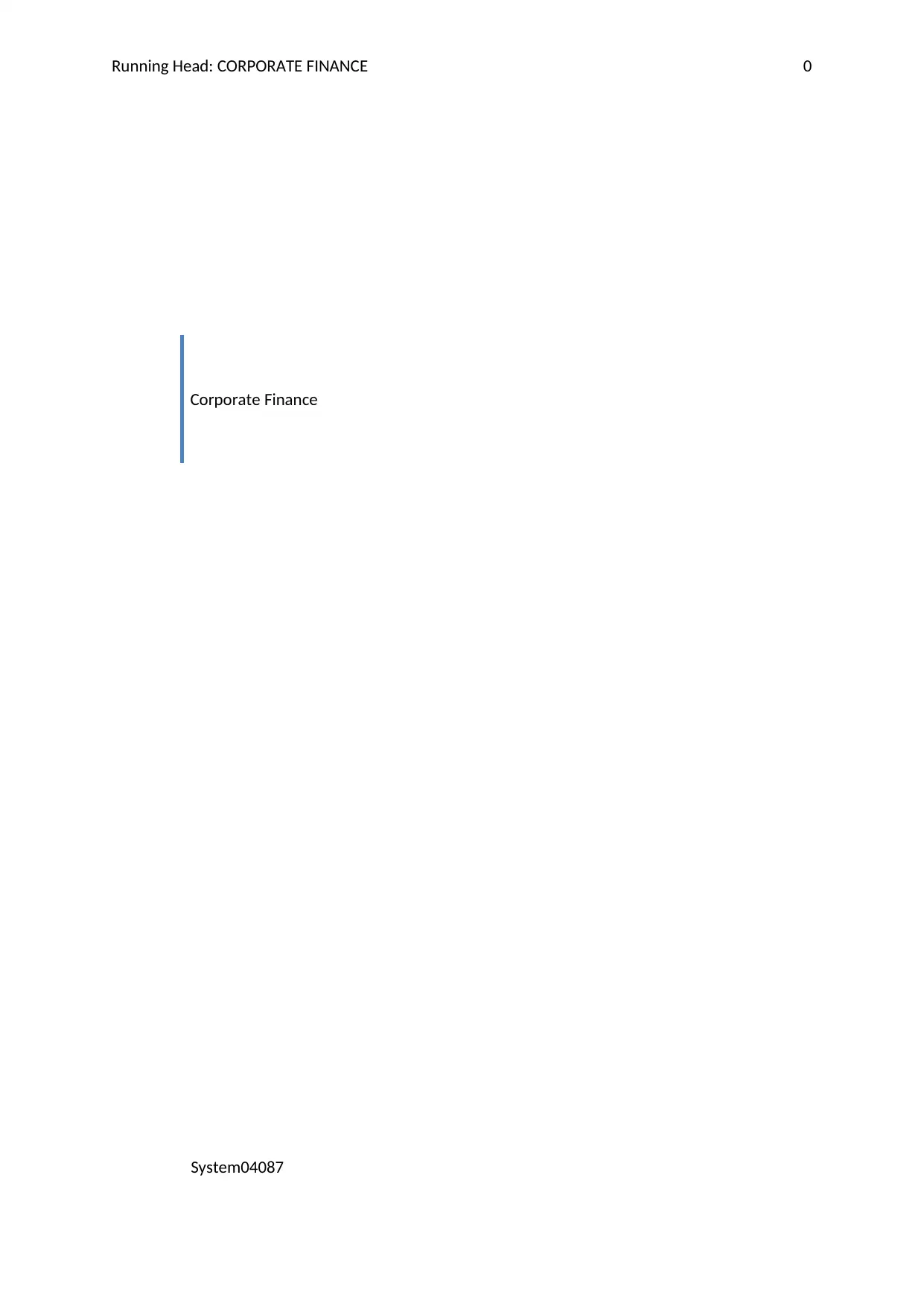
Running Head: CORPORATE FINANCE 0
Corporate Finance
System04087
Corporate Finance
System04087
Secure Best Marks with AI Grader
Need help grading? Try our AI Grader for instant feedback on your assignments.
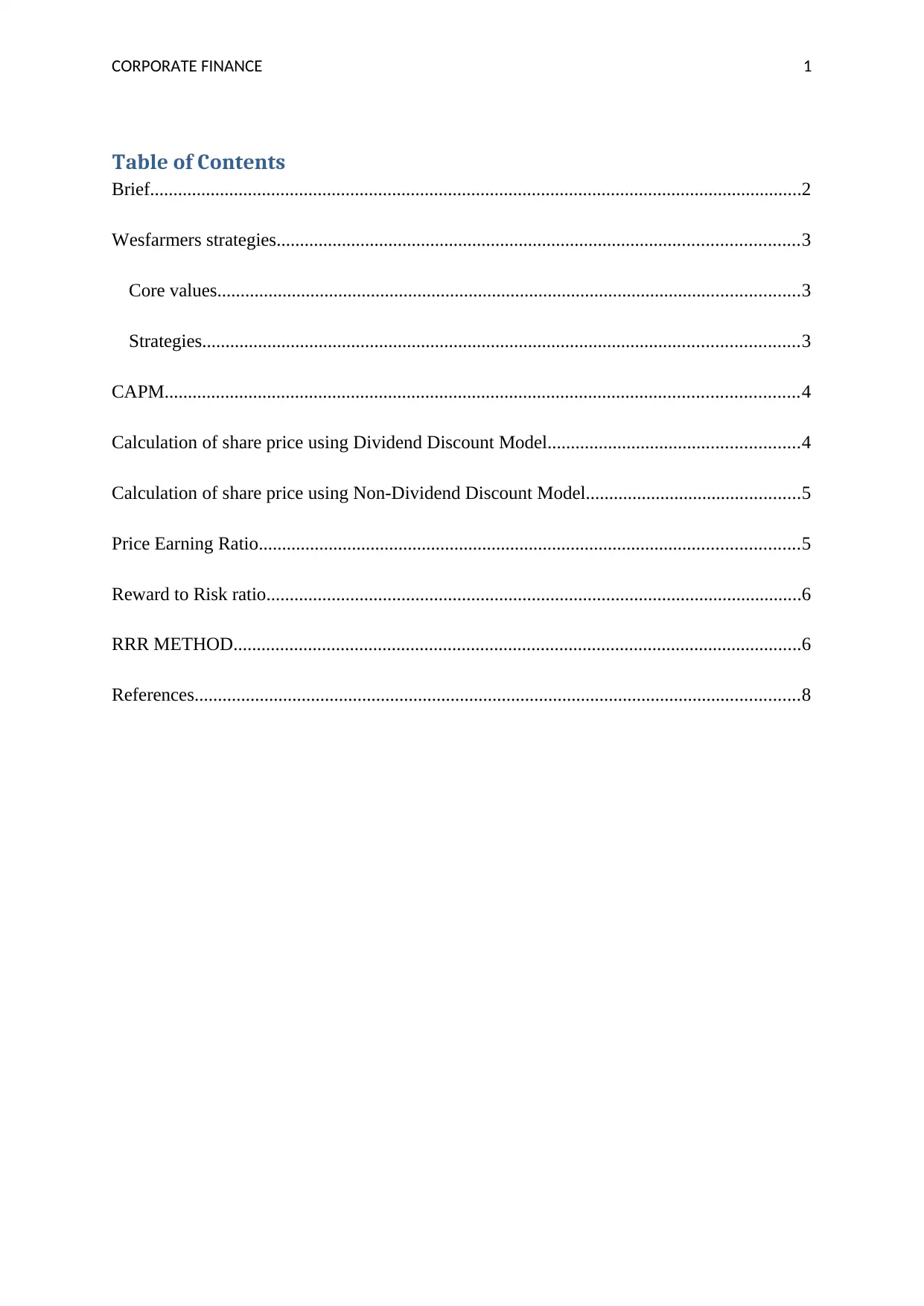
CORPORATE FINANCE 1
Table of Contents
Brief............................................................................................................................................2
Wesfarmers strategies................................................................................................................3
Core values.............................................................................................................................3
Strategies................................................................................................................................3
CAPM........................................................................................................................................4
Calculation of share price using Dividend Discount Model......................................................4
Calculation of share price using Non-Dividend Discount Model..............................................5
Price Earning Ratio....................................................................................................................5
Reward to Risk ratio...................................................................................................................6
RRR METHOD..........................................................................................................................6
References..................................................................................................................................8
Table of Contents
Brief............................................................................................................................................2
Wesfarmers strategies................................................................................................................3
Core values.............................................................................................................................3
Strategies................................................................................................................................3
CAPM........................................................................................................................................4
Calculation of share price using Dividend Discount Model......................................................4
Calculation of share price using Non-Dividend Discount Model..............................................5
Price Earning Ratio....................................................................................................................5
Reward to Risk ratio...................................................................................................................6
RRR METHOD..........................................................................................................................6
References..................................................................................................................................8
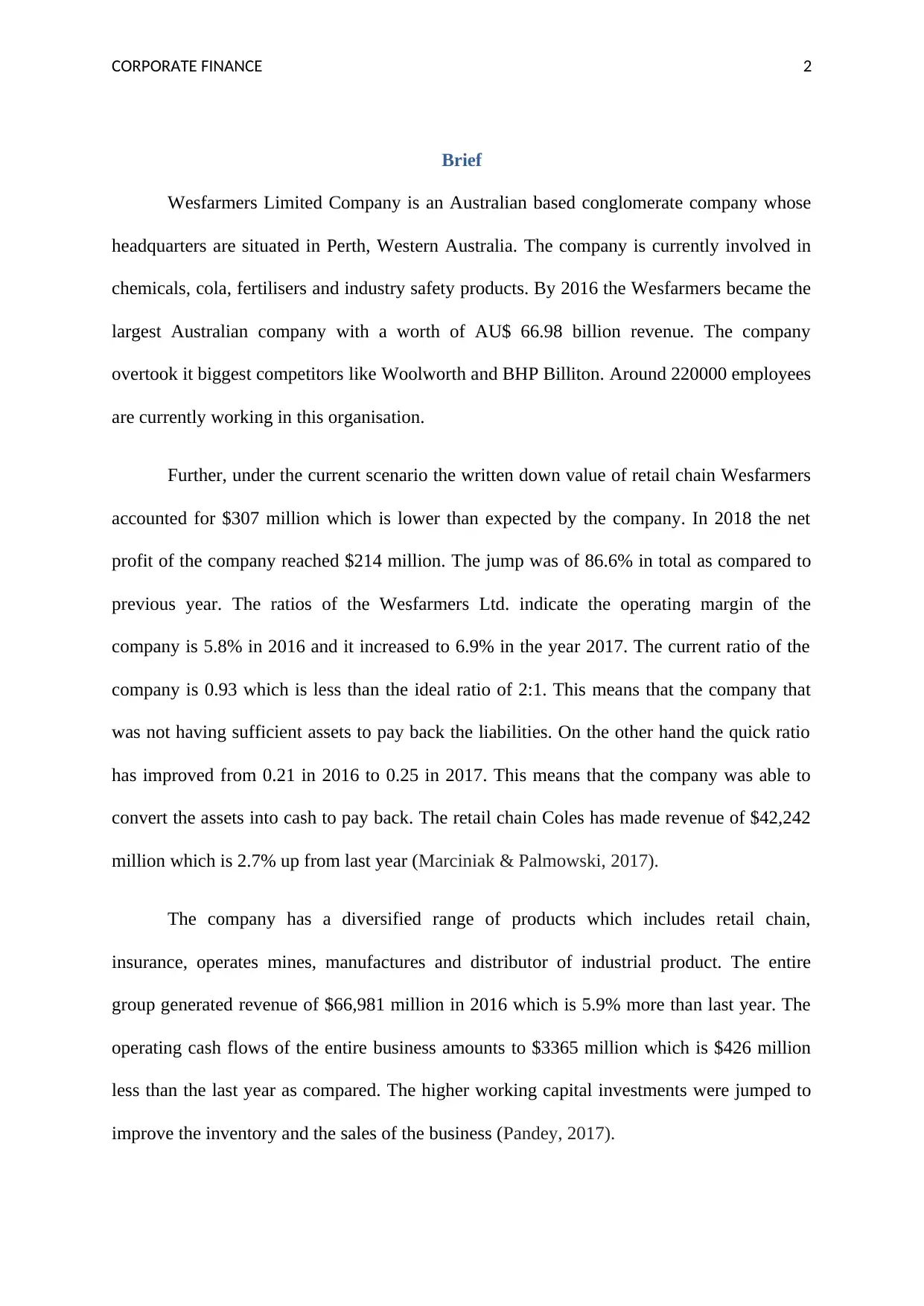
CORPORATE FINANCE 2
Brief
Wesfarmers Limited Company is an Australian based conglomerate company whose
headquarters are situated in Perth, Western Australia. The company is currently involved in
chemicals, cola, fertilisers and industry safety products. By 2016 the Wesfarmers became the
largest Australian company with a worth of AU$ 66.98 billion revenue. The company
overtook it biggest competitors like Woolworth and BHP Billiton. Around 220000 employees
are currently working in this organisation.
Further, under the current scenario the written down value of retail chain Wesfarmers
accounted for $307 million which is lower than expected by the company. In 2018 the net
profit of the company reached $214 million. The jump was of 86.6% in total as compared to
previous year. The ratios of the Wesfarmers Ltd. indicate the operating margin of the
company is 5.8% in 2016 and it increased to 6.9% in the year 2017. The current ratio of the
company is 0.93 which is less than the ideal ratio of 2:1. This means that the company that
was not having sufficient assets to pay back the liabilities. On the other hand the quick ratio
has improved from 0.21 in 2016 to 0.25 in 2017. This means that the company was able to
convert the assets into cash to pay back. The retail chain Coles has made revenue of $42,242
million which is 2.7% up from last year (Marciniak & Palmowski, 2017).
The company has a diversified range of products which includes retail chain,
insurance, operates mines, manufactures and distributor of industrial product. The entire
group generated revenue of $66,981 million in 2016 which is 5.9% more than last year. The
operating cash flows of the entire business amounts to $3365 million which is $426 million
less than the last year as compared. The higher working capital investments were jumped to
improve the inventory and the sales of the business (Pandey, 2017).
Brief
Wesfarmers Limited Company is an Australian based conglomerate company whose
headquarters are situated in Perth, Western Australia. The company is currently involved in
chemicals, cola, fertilisers and industry safety products. By 2016 the Wesfarmers became the
largest Australian company with a worth of AU$ 66.98 billion revenue. The company
overtook it biggest competitors like Woolworth and BHP Billiton. Around 220000 employees
are currently working in this organisation.
Further, under the current scenario the written down value of retail chain Wesfarmers
accounted for $307 million which is lower than expected by the company. In 2018 the net
profit of the company reached $214 million. The jump was of 86.6% in total as compared to
previous year. The ratios of the Wesfarmers Ltd. indicate the operating margin of the
company is 5.8% in 2016 and it increased to 6.9% in the year 2017. The current ratio of the
company is 0.93 which is less than the ideal ratio of 2:1. This means that the company that
was not having sufficient assets to pay back the liabilities. On the other hand the quick ratio
has improved from 0.21 in 2016 to 0.25 in 2017. This means that the company was able to
convert the assets into cash to pay back. The retail chain Coles has made revenue of $42,242
million which is 2.7% up from last year (Marciniak & Palmowski, 2017).
The company has a diversified range of products which includes retail chain,
insurance, operates mines, manufactures and distributor of industrial product. The entire
group generated revenue of $66,981 million in 2016 which is 5.9% more than last year. The
operating cash flows of the entire business amounts to $3365 million which is $426 million
less than the last year as compared. The higher working capital investments were jumped to
improve the inventory and the sales of the business (Pandey, 2017).
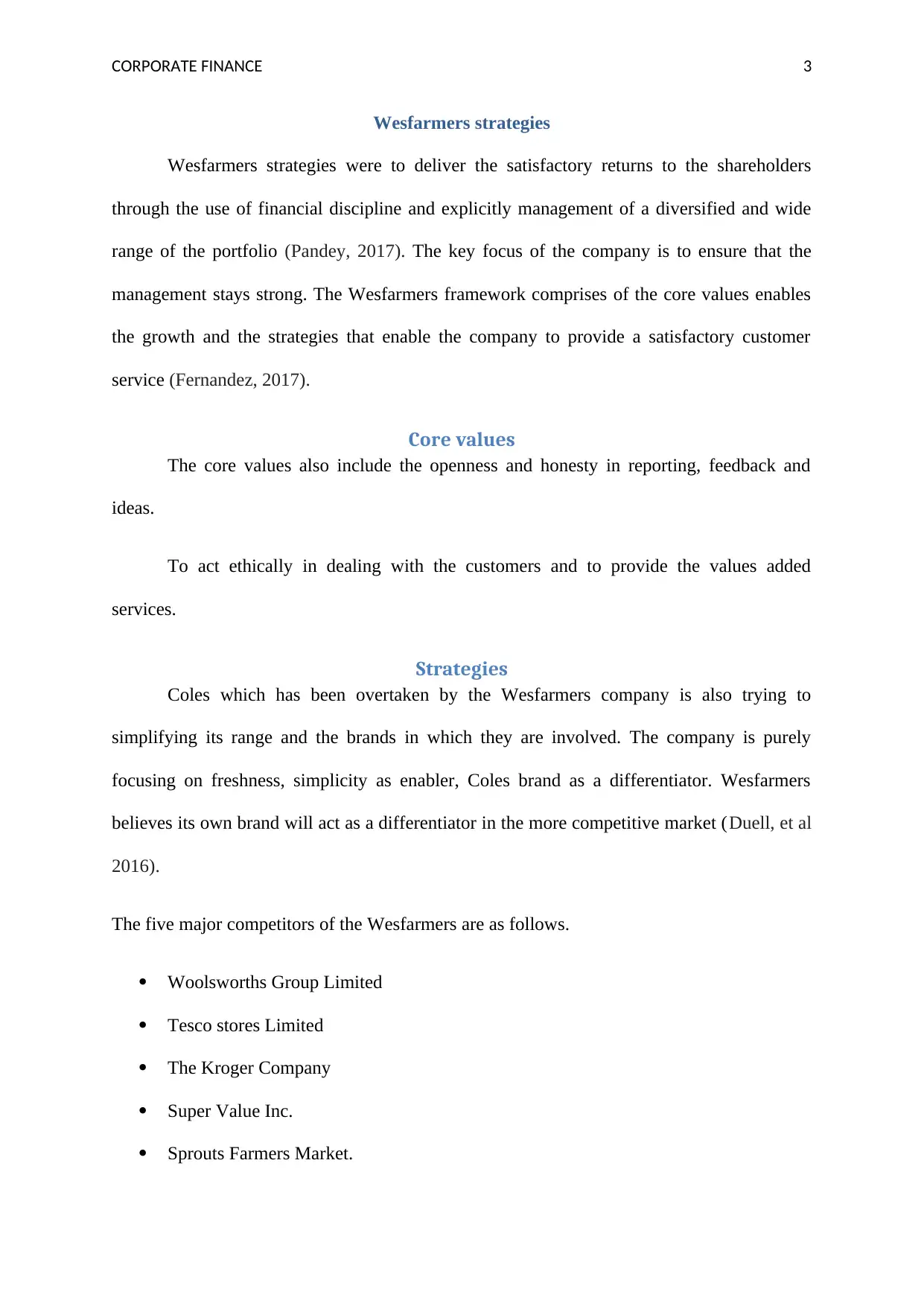
CORPORATE FINANCE 3
Wesfarmers strategies
Wesfarmers strategies were to deliver the satisfactory returns to the shareholders
through the use of financial discipline and explicitly management of a diversified and wide
range of the portfolio (Pandey, 2017). The key focus of the company is to ensure that the
management stays strong. The Wesfarmers framework comprises of the core values enables
the growth and the strategies that enable the company to provide a satisfactory customer
service (Fernandez, 2017).
Core values
The core values also include the openness and honesty in reporting, feedback and
ideas.
To act ethically in dealing with the customers and to provide the values added
services.
Strategies
Coles which has been overtaken by the Wesfarmers company is also trying to
simplifying its range and the brands in which they are involved. The company is purely
focusing on freshness, simplicity as enabler, Coles brand as a differentiator. Wesfarmers
believes its own brand will act as a differentiator in the more competitive market (Duell, et al
2016).
The five major competitors of the Wesfarmers are as follows.
Woolsworths Group Limited
Tesco stores Limited
The Kroger Company
Super Value Inc.
Sprouts Farmers Market.
Wesfarmers strategies
Wesfarmers strategies were to deliver the satisfactory returns to the shareholders
through the use of financial discipline and explicitly management of a diversified and wide
range of the portfolio (Pandey, 2017). The key focus of the company is to ensure that the
management stays strong. The Wesfarmers framework comprises of the core values enables
the growth and the strategies that enable the company to provide a satisfactory customer
service (Fernandez, 2017).
Core values
The core values also include the openness and honesty in reporting, feedback and
ideas.
To act ethically in dealing with the customers and to provide the values added
services.
Strategies
Coles which has been overtaken by the Wesfarmers company is also trying to
simplifying its range and the brands in which they are involved. The company is purely
focusing on freshness, simplicity as enabler, Coles brand as a differentiator. Wesfarmers
believes its own brand will act as a differentiator in the more competitive market (Duell, et al
2016).
The five major competitors of the Wesfarmers are as follows.
Woolsworths Group Limited
Tesco stores Limited
The Kroger Company
Super Value Inc.
Sprouts Farmers Market.
Secure Best Marks with AI Grader
Need help grading? Try our AI Grader for instant feedback on your assignments.
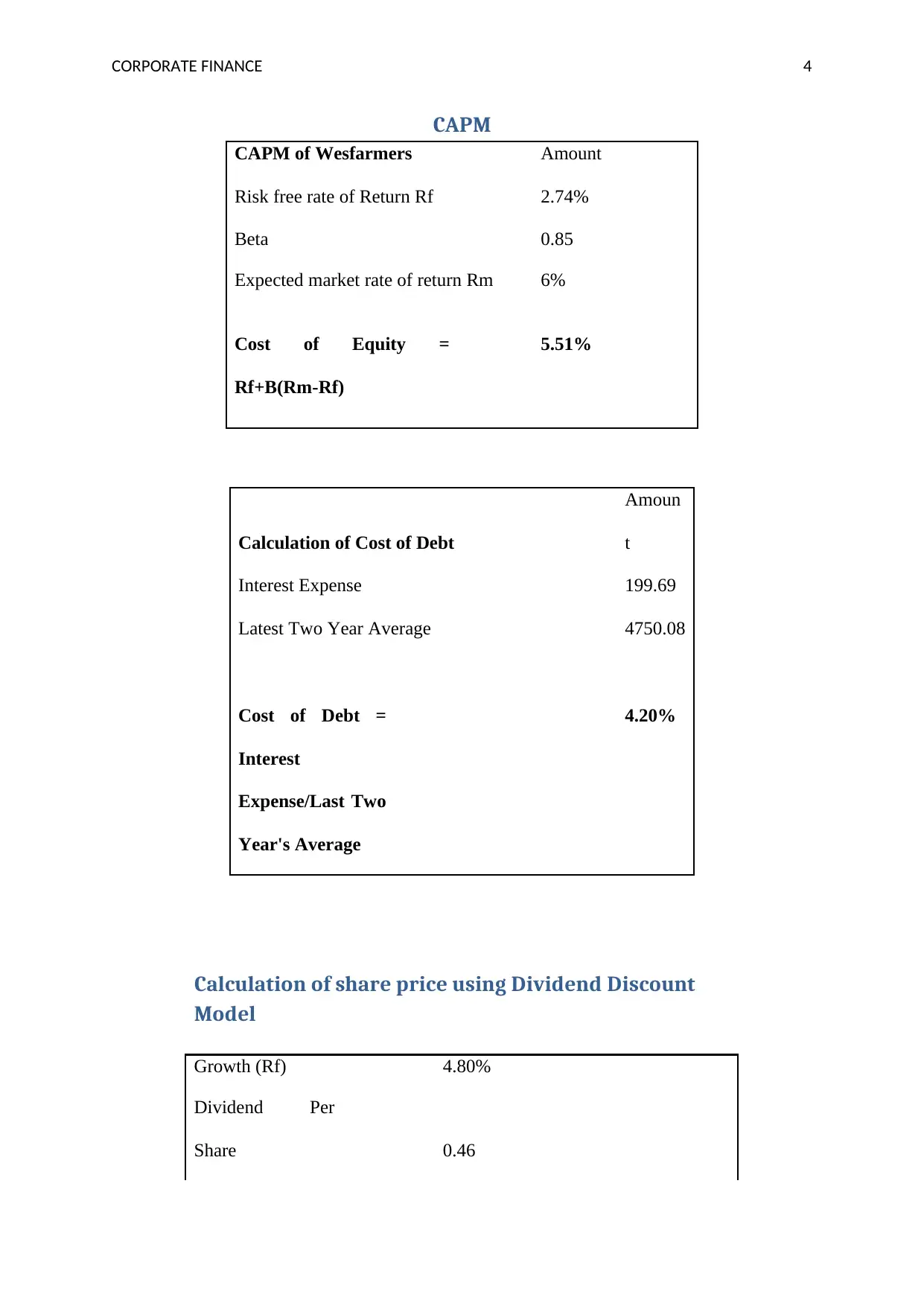
CORPORATE FINANCE 4
CAPM
CAPM of Wesfarmers Amount
Risk free rate of Return Rf 2.74%
Beta 0.85
Expected market rate of return Rm 6%
Cost of Equity =
Rf+B(Rm-Rf)
5.51%
Calculation of Cost of Debt
Amoun
t
Interest Expense 199.69
Latest Two Year Average 4750.08
Cost of Debt =
Interest
Expense/Last Two
Year's Average
4.20%
Calculation of share price using Dividend Discount
Model
Growth (Rf) 4.80%
Dividend Per
Share 0.46
CAPM
CAPM of Wesfarmers Amount
Risk free rate of Return Rf 2.74%
Beta 0.85
Expected market rate of return Rm 6%
Cost of Equity =
Rf+B(Rm-Rf)
5.51%
Calculation of Cost of Debt
Amoun
t
Interest Expense 199.69
Latest Two Year Average 4750.08
Cost of Debt =
Interest
Expense/Last Two
Year's Average
4.20%
Calculation of share price using Dividend Discount
Model
Growth (Rf) 4.80%
Dividend Per
Share 0.46
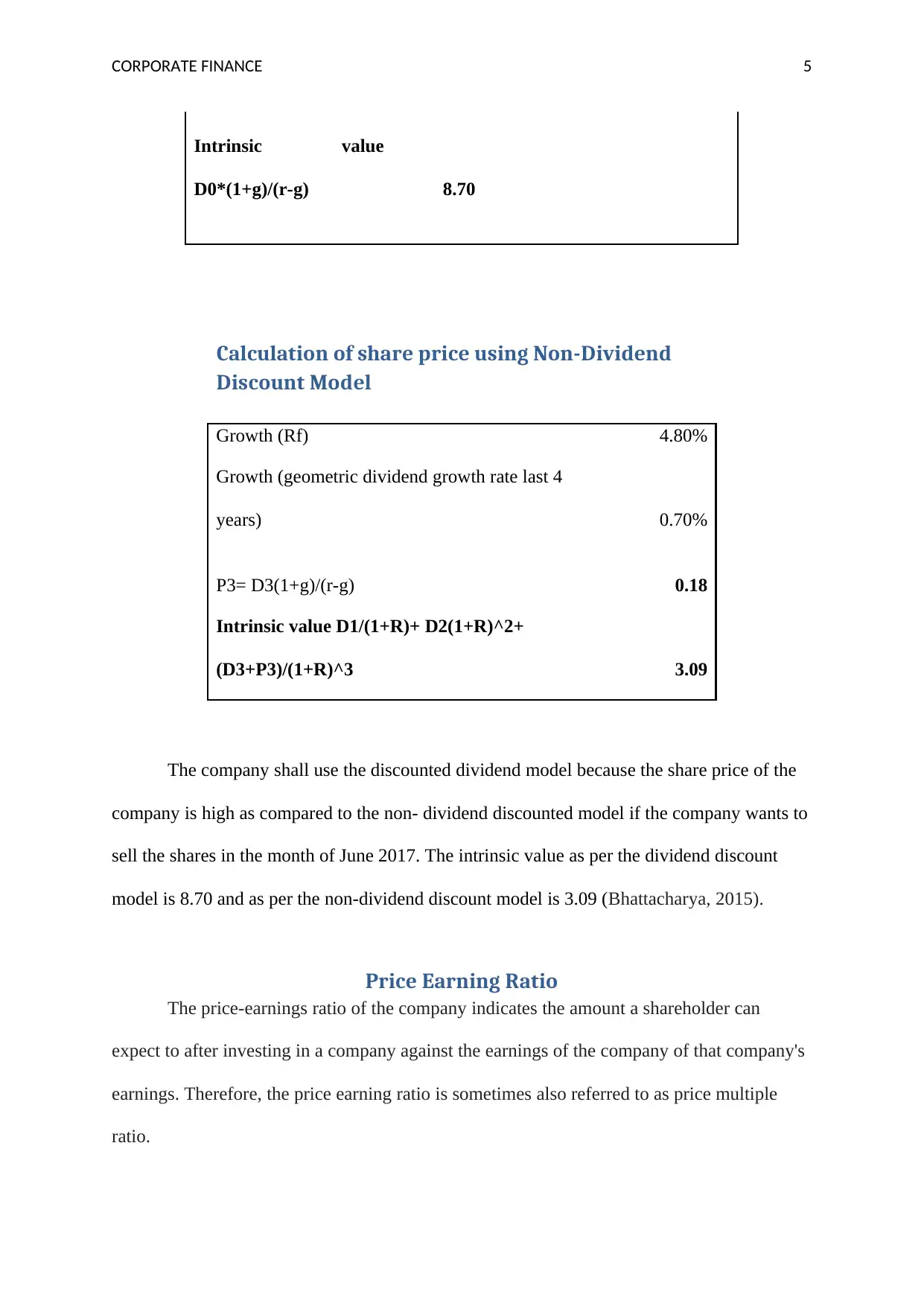
CORPORATE FINANCE 5
Intrinsic value
D0*(1+g)/(r-g) 8.70
Calculation of share price using Non-Dividend
Discount Model
Growth (Rf) 4.80%
Growth (geometric dividend growth rate last 4
years) 0.70%
P3= D3(1+g)/(r-g) 0.18
Intrinsic value D1/(1+R)+ D2(1+R)^2+
(D3+P3)/(1+R)^3 3.09
The company shall use the discounted dividend model because the share price of the
company is high as compared to the non- dividend discounted model if the company wants to
sell the shares in the month of June 2017. The intrinsic value as per the dividend discount
model is 8.70 and as per the non-dividend discount model is 3.09 (Bhattacharya, 2015).
Price Earning Ratio
The price-earnings ratio of the company indicates the amount a shareholder can
expect to after investing in a company against the earnings of the company of that company's
earnings. Therefore, the price earning ratio is sometimes also referred to as price multiple
ratio.
Intrinsic value
D0*(1+g)/(r-g) 8.70
Calculation of share price using Non-Dividend
Discount Model
Growth (Rf) 4.80%
Growth (geometric dividend growth rate last 4
years) 0.70%
P3= D3(1+g)/(r-g) 0.18
Intrinsic value D1/(1+R)+ D2(1+R)^2+
(D3+P3)/(1+R)^3 3.09
The company shall use the discounted dividend model because the share price of the
company is high as compared to the non- dividend discounted model if the company wants to
sell the shares in the month of June 2017. The intrinsic value as per the dividend discount
model is 8.70 and as per the non-dividend discount model is 3.09 (Bhattacharya, 2015).
Price Earning Ratio
The price-earnings ratio of the company indicates the amount a shareholder can
expect to after investing in a company against the earnings of the company of that company's
earnings. Therefore, the price earning ratio is sometimes also referred to as price multiple
ratio.
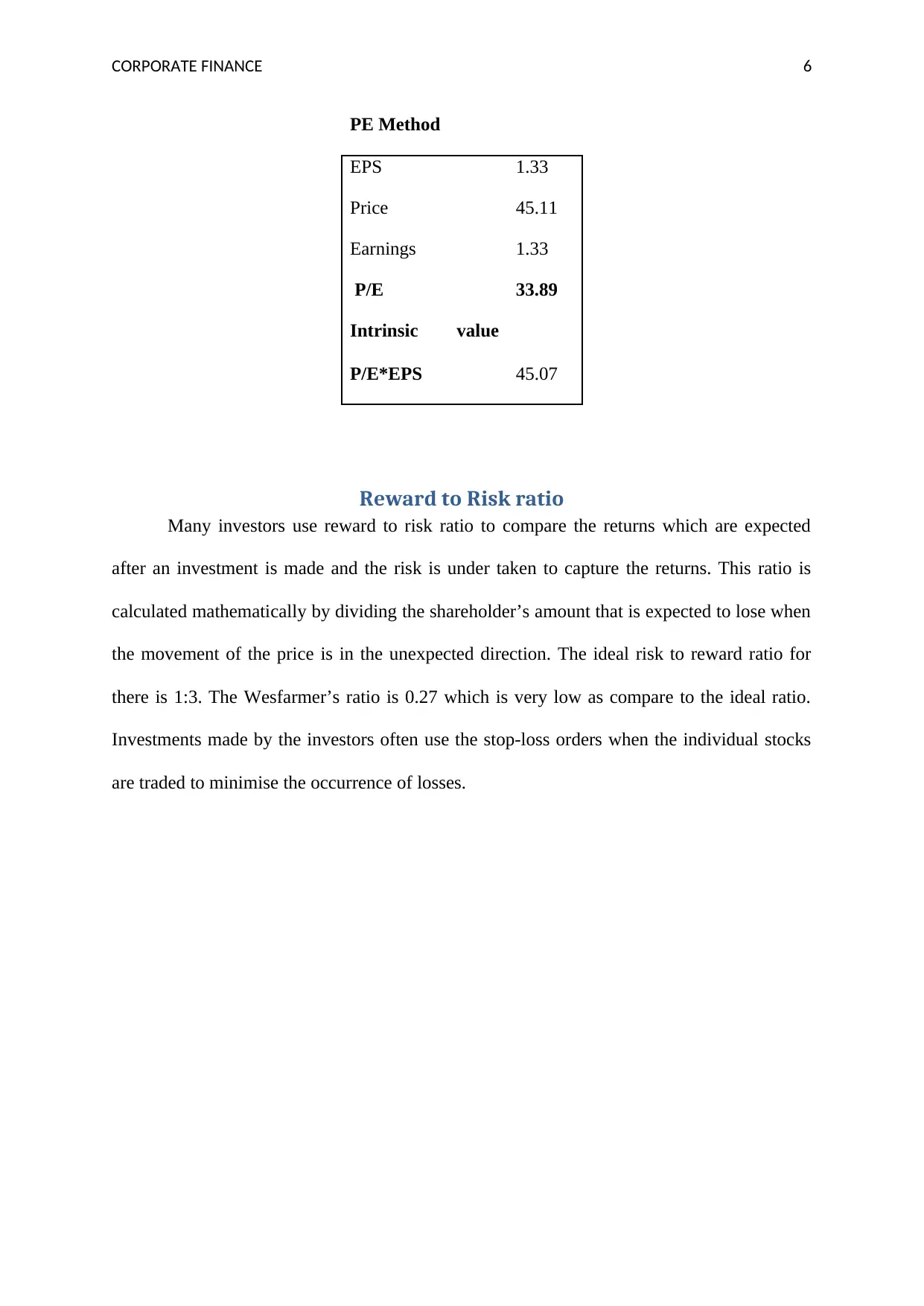
CORPORATE FINANCE 6
PE Method
EPS 1.33
Price 45.11
Earnings 1.33
P/E 33.89
Intrinsic value
P/E*EPS 45.07
Reward to Risk ratio
Many investors use reward to risk ratio to compare the returns which are expected
after an investment is made and the risk is under taken to capture the returns. This ratio is
calculated mathematically by dividing the shareholder’s amount that is expected to lose when
the movement of the price is in the unexpected direction. The ideal risk to reward ratio for
there is 1:3. The Wesfarmer’s ratio is 0.27 which is very low as compare to the ideal ratio.
Investments made by the investors often use the stop-loss orders when the individual stocks
are traded to minimise the occurrence of losses.
PE Method
EPS 1.33
Price 45.11
Earnings 1.33
P/E 33.89
Intrinsic value
P/E*EPS 45.07
Reward to Risk ratio
Many investors use reward to risk ratio to compare the returns which are expected
after an investment is made and the risk is under taken to capture the returns. This ratio is
calculated mathematically by dividing the shareholder’s amount that is expected to lose when
the movement of the price is in the unexpected direction. The ideal risk to reward ratio for
there is 1:3. The Wesfarmer’s ratio is 0.27 which is very low as compare to the ideal ratio.
Investments made by the investors often use the stop-loss orders when the individual stocks
are traded to minimise the occurrence of losses.
Paraphrase This Document
Need a fresh take? Get an instant paraphrase of this document with our AI Paraphraser
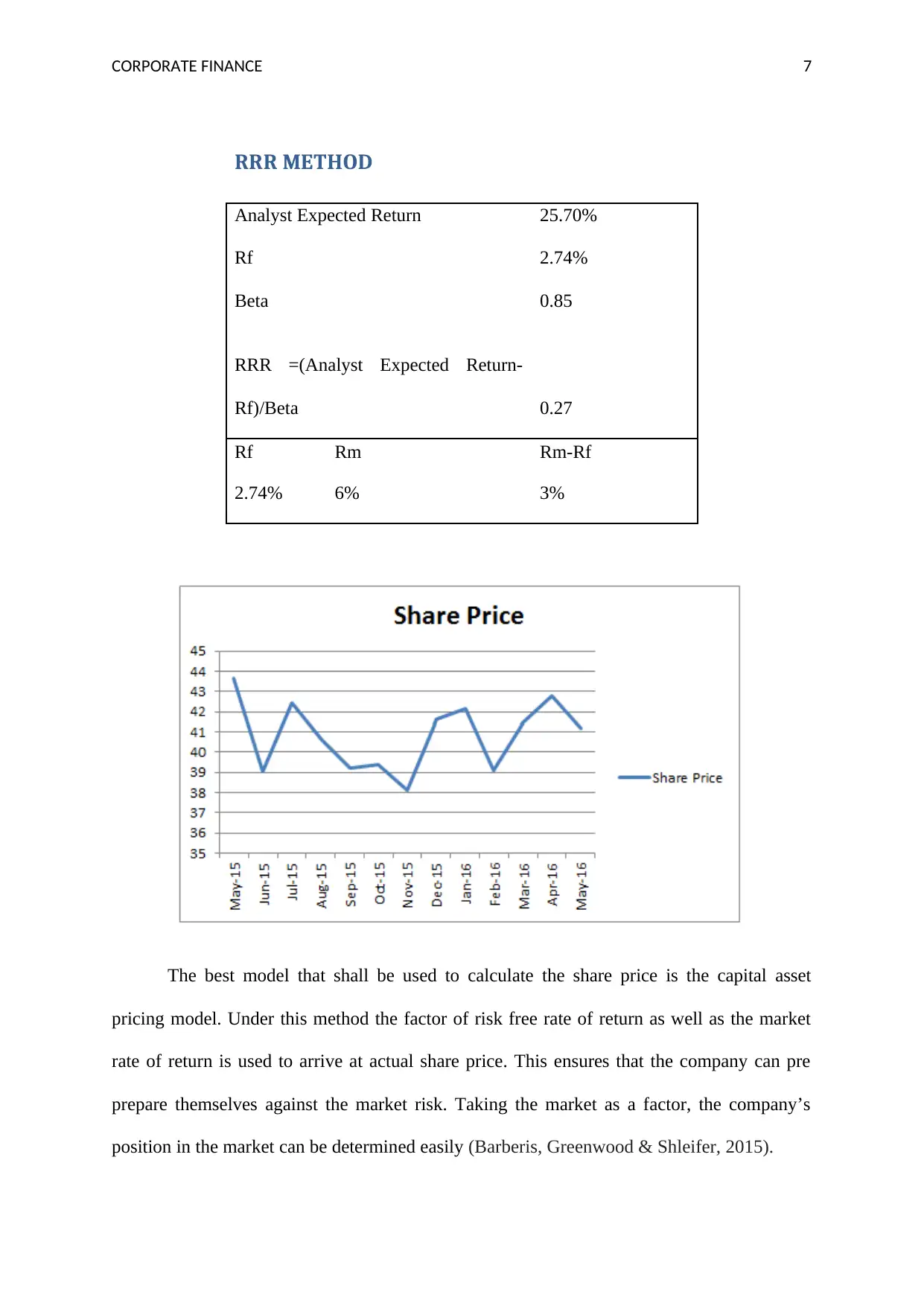
CORPORATE FINANCE 7
RRR METHOD
Analyst Expected Return 25.70%
Rf 2.74%
Beta 0.85
RRR =(Analyst Expected Return-
Rf)/Beta 0.27
Rf Rm Rm-Rf
2.74% 6% 3%
The best model that shall be used to calculate the share price is the capital asset
pricing model. Under this method the factor of risk free rate of return as well as the market
rate of return is used to arrive at actual share price. This ensures that the company can pre
prepare themselves against the market risk. Taking the market as a factor, the company’s
position in the market can be determined easily (Barberis, Greenwood & Shleifer, 2015).
RRR METHOD
Analyst Expected Return 25.70%
Rf 2.74%
Beta 0.85
RRR =(Analyst Expected Return-
Rf)/Beta 0.27
Rf Rm Rm-Rf
2.74% 6% 3%
The best model that shall be used to calculate the share price is the capital asset
pricing model. Under this method the factor of risk free rate of return as well as the market
rate of return is used to arrive at actual share price. This ensures that the company can pre
prepare themselves against the market risk. Taking the market as a factor, the company’s
position in the market can be determined easily (Barberis, Greenwood & Shleifer, 2015).
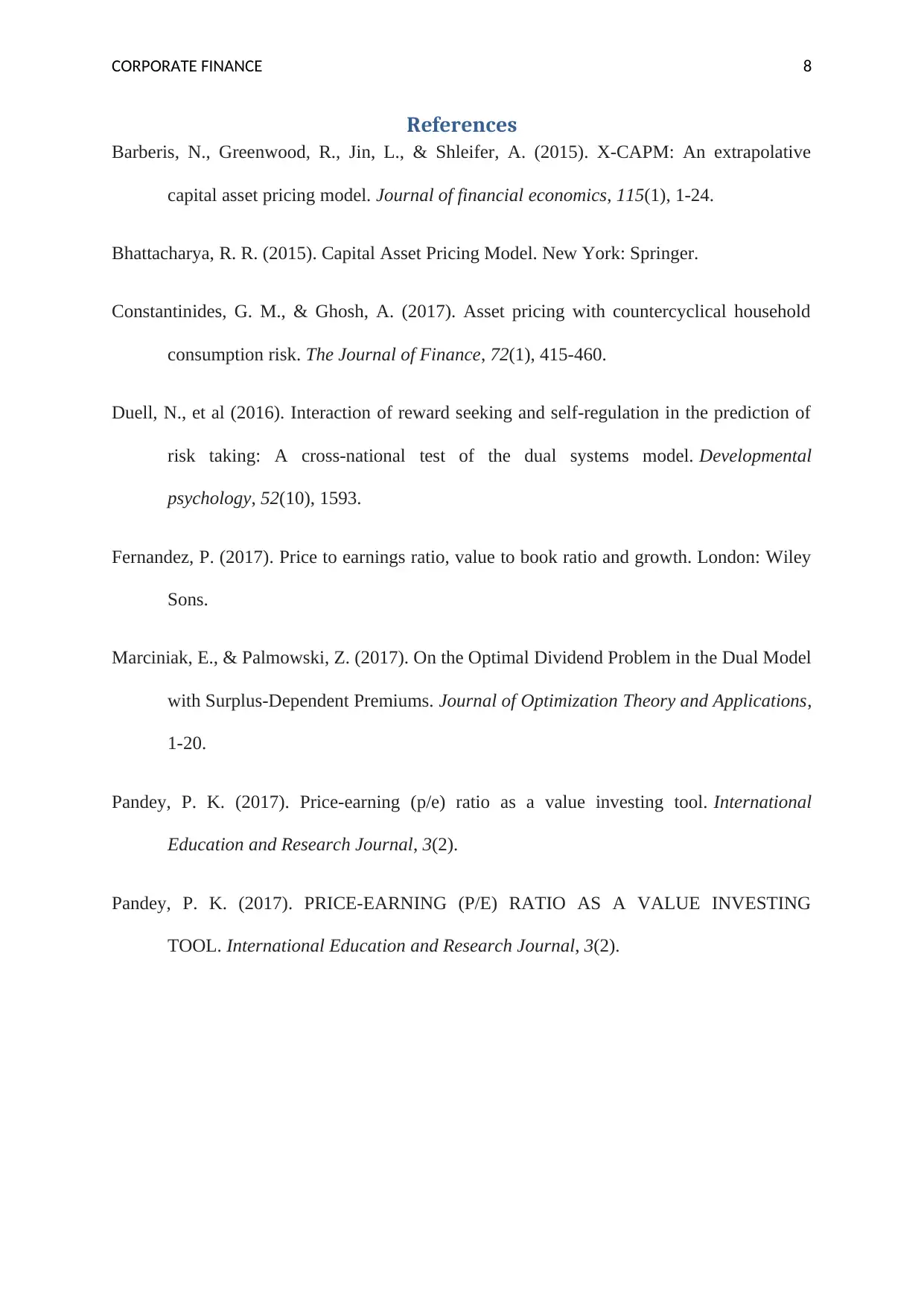
CORPORATE FINANCE 8
References
Barberis, N., Greenwood, R., Jin, L., & Shleifer, A. (2015). X-CAPM: An extrapolative
capital asset pricing model. Journal of financial economics, 115(1), 1-24.
Bhattacharya, R. R. (2015). Capital Asset Pricing Model. New York: Springer.
Constantinides, G. M., & Ghosh, A. (2017). Asset pricing with countercyclical household
consumption risk. The Journal of Finance, 72(1), 415-460.
Duell, N., et al (2016). Interaction of reward seeking and self-regulation in the prediction of
risk taking: A cross-national test of the dual systems model. Developmental
psychology, 52(10), 1593.
Fernandez, P. (2017). Price to earnings ratio, value to book ratio and growth. London: Wiley
Sons.
Marciniak, E., & Palmowski, Z. (2017). On the Optimal Dividend Problem in the Dual Model
with Surplus-Dependent Premiums. Journal of Optimization Theory and Applications,
1-20.
Pandey, P. K. (2017). Price-earning (p/e) ratio as a value investing tool. International
Education and Research Journal, 3(2).
Pandey, P. K. (2017). PRICE-EARNING (P/E) RATIO AS A VALUE INVESTING
TOOL. International Education and Research Journal, 3(2).
References
Barberis, N., Greenwood, R., Jin, L., & Shleifer, A. (2015). X-CAPM: An extrapolative
capital asset pricing model. Journal of financial economics, 115(1), 1-24.
Bhattacharya, R. R. (2015). Capital Asset Pricing Model. New York: Springer.
Constantinides, G. M., & Ghosh, A. (2017). Asset pricing with countercyclical household
consumption risk. The Journal of Finance, 72(1), 415-460.
Duell, N., et al (2016). Interaction of reward seeking and self-regulation in the prediction of
risk taking: A cross-national test of the dual systems model. Developmental
psychology, 52(10), 1593.
Fernandez, P. (2017). Price to earnings ratio, value to book ratio and growth. London: Wiley
Sons.
Marciniak, E., & Palmowski, Z. (2017). On the Optimal Dividend Problem in the Dual Model
with Surplus-Dependent Premiums. Journal of Optimization Theory and Applications,
1-20.
Pandey, P. K. (2017). Price-earning (p/e) ratio as a value investing tool. International
Education and Research Journal, 3(2).
Pandey, P. K. (2017). PRICE-EARNING (P/E) RATIO AS A VALUE INVESTING
TOOL. International Education and Research Journal, 3(2).
1 out of 9
Related Documents
Your All-in-One AI-Powered Toolkit for Academic Success.
+13062052269
info@desklib.com
Available 24*7 on WhatsApp / Email
![[object Object]](/_next/static/media/star-bottom.7253800d.svg)
Unlock your academic potential
© 2024 | Zucol Services PVT LTD | All rights reserved.





